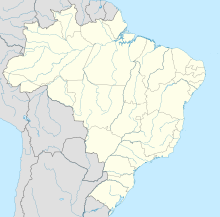Cachimbo Airport
|
Cachimbo Airport Aeroporto de Cachimbo |
|||||||||||
|---|---|---|---|---|---|---|---|---|---|---|---|
| Summary | |||||||||||
| Airport type | Military: Airport | ||||||||||
| Operator | Brazilian Air Force | ||||||||||
| Serves | Serra do Cachimbo | ||||||||||
| Built | 1950 | ||||||||||
| In use | 1954 - present | ||||||||||
| Elevation AMSL | 537 m / 1,762 ft | ||||||||||
| Coordinates | 09°20′02″S 054°57′55″W / 9.33389°S 54.96528°WCoordinates: 09°20′02″S 054°57′55″W / 9.33389°S 54.96528°W | ||||||||||
| Website | http://www.cpbv.aer.mil.br/ | ||||||||||
| Map | |||||||||||
| Location in Brazil | |||||||||||
| Runways | |||||||||||
|
|||||||||||
|
Sources: Military Base Website,Brazilian Air Force
|
|||||||||||
Cachimbo Airport (ICAO: SBCC) is the military airport serving Campo de Provas Brigadeiro Velloso, a large Testing and Training complex of the Brazilian Armed Forces located in Serra do Cachimbo (English: Smoking pipe Mountains), in the southern part of the state of Pará, Brazil.
It is operated by the Brazilian Air Force.
The Testing and Training Complex of Campo de Provas Brigadeiro Velloso has an area of 21,588 km2 and a perimeter of 653 km. It is within the limits of four municipalities: Altamira, Itaituba, Jacareacanga and Novo Progresso, in an area comparable in size to the Brazilian state of Sergipe.
The airport and the complex have their origins in an airfield opened on September 3, 1950. With the end of World War II, the Brazilian government saw the need for a strategic support facility to the operation of aircraft flying between the Northern Region (location of the Amazon Rainforest) and the Southeast Region of Brazil (the locations of Rio de Janeiro and São Paulo), flying on a straight route. Before the construction of the airfield, the link was only possible to be operated with safety following the longer coastline route. The airfield was officially commissioned on January 20, 1954.
...
Wikipedia

